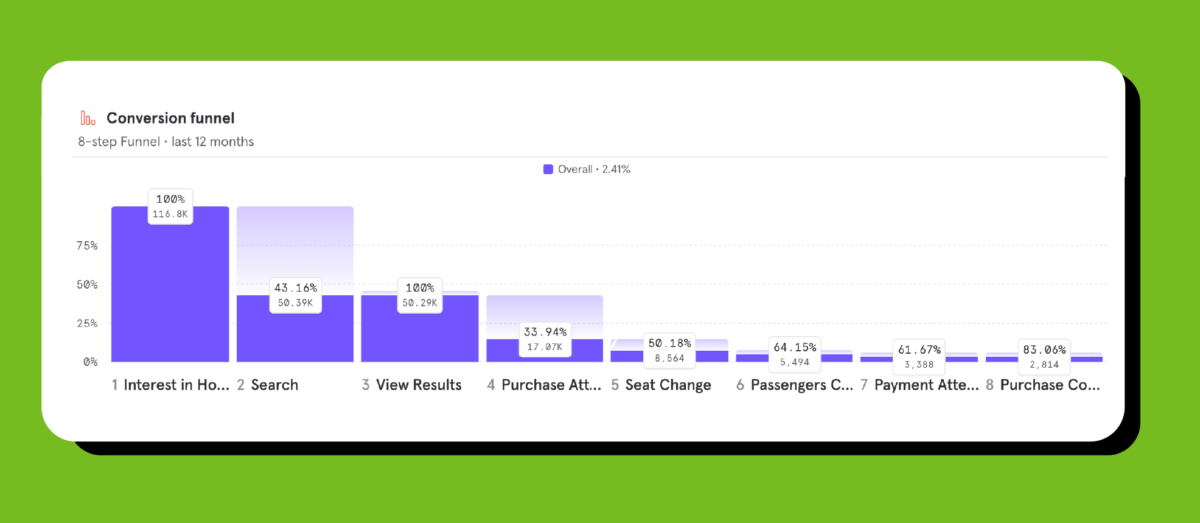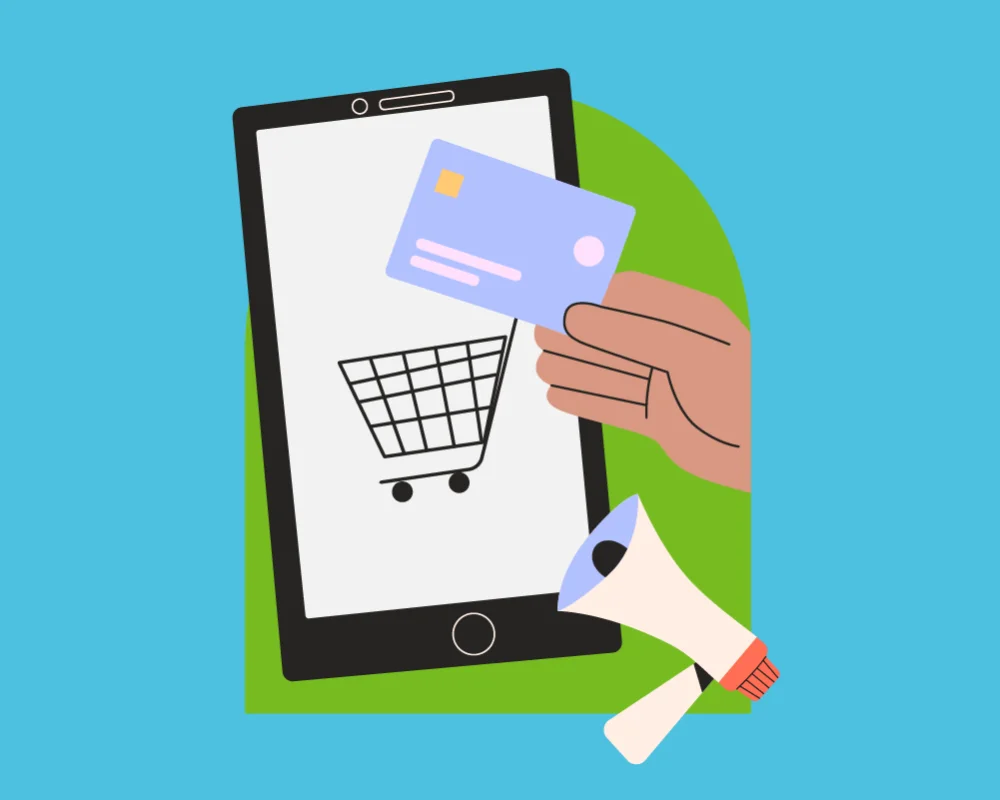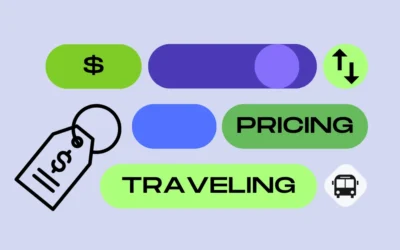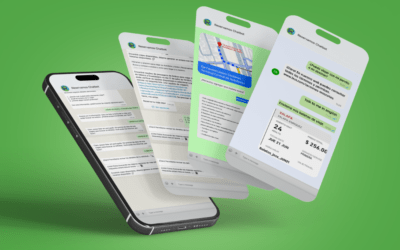Incorporating specialized technology in the bus sector to connect with more travelers digitally allows access to the analysis of the generated data to delve into user behavior on your own online sales channels, thereby identifying opportunities to enhance competitiveness.
Having control over ticket sales on your own website and access to visitor behavior data in the sales funnel provides valuable insights for creating user acquisition strategies, improving the user experience, crafting personalized marketing campaigns, and optimizing routes and schedules to offer more travel options. Understanding this type of information and combining it with the right metrics tells you whether your efforts are meeting your business objectives.
However, in the land transport sector, online sales have been dominated by marketplaces that drive traffic to their websites and process purchases for multiple bus companies, making behavioral data and metrics unknown to bus companies now trying to regain control of sales on their own websites.
That’s why in this article, we share the metrics and key concepts you should be aware of to create better commercial strategies for online sales. Delving into this kind of information will allow you to make more informed decisions, optimize routes and schedules, and personalize the traveler’s experience.
Furthermore, it facilitates the identification of market trends and changes, allowing companies to remain competitive in a constantly evolving digital environment. By improving operational efficiency, reducing costs, and increasing revenue, this technology becomes a key accelerator for sustainable success in the land transport industry.
Hence the importance of understanding the main eCommerce concepts and making the most of the available information and data 24 hours a day. In this article, we will explore ten essential concepts and their relevance to the business.
- Sales Funnel
The sales funnel represents the process a user follows from the moment they visit the website, show interest in a route and schedule, select it, and complete a purchase. Understanding this journey allows you to optimize the sales process.
- Traffic
It is the number of users who interact with either the website or mobile application. This traffic represents the flow of potential travelers who explore route offerings, view schedules, and prices, and can become bus ticket buyers. High traffic is essential for the success of an eCommerce platform. Having access to key metrics allows you to create marketing campaigns that attract users who intend to travel, aiming to increase conversion rates.
- Interest in Home
It is the homepage of the eCommerce platform. In this initial stage of the purchasing journey, it is possible to track various essential data to understand the origin and behavior of visitors. This includes information about the geolocation of users, tracking of marketing campaigns that attracted the user, identification of referring domains, the preferred search engine of users, and data at the country and regional levels. All of this data is crucial for analyzing and optimizing the performance of online user acquisition campaigns.

- Search Engine
Allows visitors to select travel details such as origin and destination, travel date, ticket type, seat selection, passenger information, and payment method selection. There are different steps to complete a purchase depending on business rules. In this part, providing a good user experience is essential, streamlining the process between each step to avoid errors that may cause users to drop off.
- Purchase Attempt
Displays options for schedules and service levels available on the selected route. Here, you can analyze when a user performs a search to determine the days of the week or periods of the month when searches are conducted. Additionally, it identifies the most popular days for return trips on a specific route and measures the average travel duration. By combining various reports and data, such as the most sought-after routes and days, you gain a deeper understanding of user behavior, enabling more informed and strategic decision-making.
- Passengers Created
Refers to the moment when a user selects a schedule and proceeds to choose their seat during the purchase process. It allows tracking routes with the most purchase attempts in a specific period, as well as visualizing the days and hours when most purchases are made for a specific route. Additionally, it is possible to obtain information about future purchase attempts for a route during a specific time and hour. This provides the opportunity for more precise analysis and strategic planning of the bus fleet, as well as taking additional measures to attract more users if high demand is observed during a particular time.
- Payment Attempt
Refers to the stage where users provide personal information such as name, last name, and email to create a passenger profile. This section allows for determining which routes travelers who frequently attempt to make purchases originate from. Calculating the number of passengers included in a single transaction is also possible. This metric can be segmented by route and schedule, providing detailed information about purchase attempts and the number of tickets in each, essential for demand analysis and strategic planning.
- Purchase Completed
Indicates that the payment process has been successfully completed, and the traveler has acquired their digital tickets. This metric allows for evaluating demand on different routes and schedules. Additionally, it is possible to track the use of discount codes to determine how many have been redeemed in each purchase and on which specific routes. This facilitates tracking the impact of promotions. Moreover, it allows identifying how many tickets have been purchased for round trips compared to single tickets, which is valuable for encouraging round-trip ticket purchases and increasing the average ticket price per purchase.
- Conversion
Refers to when a user successfully completes a transaction and acquires a bus ticket or another related service, such as booking a trip. Conversion is a key indicator of success in eCommerce since it represents the ultimate goal of the company: turning visitors into future travelers. Tracking and optimizing conversion rates are essential to improving the profitability and performance of an eCommerce platform.
- Cohorts
Used to create groups of users with similar characteristics, such as repeat buyers, inactive users, and users who do not complete purchases, among others. These metrics help tailor marketing and remarketing strategies and foster traveler loyalty.
Knowing and analyzing these concepts provides a competitive advantage. With constant access to valuable data, any bus company can optimize its strategies and offer travelers a streamlined, simple, and secure purchasing experience.
Prepare to take your business to the next level in the digital world!




